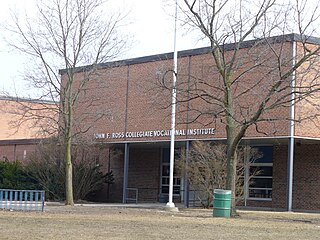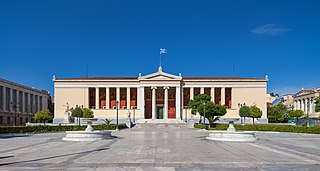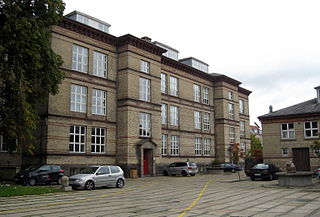
Vocational education is education that prepares people for a skilled craft as an artisan, trade as a tradesperson, or work as a technician. Vocational education can also be seen as that type of education given to an individual to prepare that individual to be gainfully employed or self employed with requisite skill. Vocational education is known by a variety of names, depending on the country concerned, including career and technical education, or acronyms such as TVET and TAFE.

Education in the Netherlands is characterized by division: education is oriented toward the needs and background of the pupil. Education is divided over schools for different age groups, some of which are divided in streams for different educational levels. Schools are furthermore divided in public, special (religious), and general-special (neutral) schools, although there are also a few private schools. The Dutch grading scale runs from 1 to 10 (outstanding).

Gymnasium is a term in various European languages for a secondary school that prepares students for higher education at a university. It is comparable to the US English term preparatory high school. Before the 20th century, the gymnasium system was a widespread feature of educational systems throughout many European countries.
Education in Slovakia consists of a free education system based on 10 years of compulsory school attendance.

Education in Greece is centralized and governed by the Ministry of Education and Religious Affairs at all grade levels in elementary and middle school. The Ministry exercises control over public schools, formulates and implements legislation, administers the budget, coordinates national level university entrance examinations, sets up the national curriculum, appoints public school teaching staff, and coordinates other services.
The Danish gymnasium offers a 3-year general academically-oriented upper secondary programme which builds on the 9th-10th form of the Folkeskole and leads to the upper secondary school exit examination. This qualifies a student for admission to higher education Preparatory, subject to the special entrance regulations applying to the individual higher education programmes. Colloquially, gymnasium refers to what is formally called STX.
The Higher Preparatory Examination is a 2-year general upper secondary programme building on to the 10th form of the Folkeskole and leading to the higher preparatory examination, which qualifies for admission to higher education, subject to the special entrance regulations applying to the individual higher education programmes.
In Denmark, the Higher Technical Examination Programme is a 3-year vocationally oriented general upper secondary programme which builds on the 10th-11th form of the Folkeskole. It leads to the higher technical examination, the HTX-examination, which permits a student to qualify for admission to higher education, subject to the special entrance regulations that apply to the individual course. The programme gives special attention to scientific, technical and communicative subjects. HTX graduates may study at any Danish technical, scientific or traditional university as well as technical and technological academy (akademi) or college (professionshøjskole).
Education in Norway is mandatory for all children aged from 6 to 16. Schools are typically divided into two divisions: primary and lower secondary schooling. The majority of schools in Norway are municipal, where local governments fund and manage administration. Primary and lower secondary schools are available free of charge for all Norwegian citizens as a given right.
The system of education in Iceland is divided in four levels: playschool, compulsory, upper secondary and higher, and is similar to that of other Nordic countries. Education is mandatory for children aged 6–16. Most institutions are funded by the state; there are very few private schools in the country. Iceland is a country with gymnasia.
Vocational secondary education in Denmark takes place at special state-funded vocational schools (erhvervsskoler), most of which are either technical schools or business colleges (handelsskoler). The creation of vocational training began as early as the 1400s, but wasn't fully established until 1875 when Denmark passed legislation that would allow for the use of government grants towards technical and training schools. Vocational training schools are jointly run by business and trade associations, such as unions who hope to create a form of stream-lined training into the labour force. Through a combination of teaching in vocational schools and apprenticeship, mostly in private companies, students are trained for work in eight specific fields which include: construction, commerce, metal, agriculture, transportation, food, service, and media.
The first documented school in Lithuania was established in 1387 at Vilnius Cathedral. The school network was influenced by the Christianization of Lithuania. Several types of schools were present in medieval Lithuania – cathedral schools, where pupils were prepared for priesthood; parish schools, offering elementary education; and home schools dedicated to educating the children of the Lithuanian nobility. Before Vilnius University was established in 1579, Lithuanians seeking higher education attended universities in foreign cities, including Kraków, Prague, and Leipzig, among others. During the Interbellum a national university – Vytautas Magnus University was founded in Kaunas.
Ishøj Gymnasium was a secondary school located in Ishøj near Copenhagen, Denmark.

The Danish Voksenuddannelsescentre is the general adult education programme which is part of the public education system in Denmark. There are 29 adult education centres (VUCs) in Denmark.

The levels of education in the Faroe Islands are primary, secondary and higher education. Most institutions are funded by the state; there are few private schools in the country. Education is compulsory for 9 years between the ages of 7 and 16.

Viby Gymnasium is a school of secondary education in the neighborhood Viby J in Aarhus, Denmark. The school offers the 2 year Higher Preparatory Examination (HF) programme, the 3 year Matriculation examination (STX) programme and a vocational programme (EUX).

Aarhus Business College is a business school of secondary education in Aarhus, Denmark. The school offers educational programmes in business and management on a secondary level to post-primary youth, Higher Commercial Examination Programme (HHX) and supplementary courses for adults seeking to maintain qualifications. Last but not least Aarhus Business College has two new types of educations called EUX Business and EUD Business. EUX is an education that combines a 2-year secondary education with a 2-year internship in a company, and EUD is 1 year in school and a 2-year internship in a company. It is an independent self-owned institution under the Danish government, managed by a board composed of members from the business community in conjunction with a rector that oversees day-to-day operations. The school is located on three addresses in Aarhus: Campus Sønderhøj in Viby J and the two campuses of HHX in Risskov and Viby J.
Niels Brock Copenhagen Business College, usually referred to simply as Niels Brock, is a school of secondary education and post-secondary education in Copenhagen, Denmark. The school offers programmes within business and management including Vocational Education and Training (VET), Higher Commercial Examination Programme (HHX), Bachelor in Business Administration, Master in International Business Management, Master of Business Administration, and supplementary courses for adults seeking to maintain qualifications. It is an independent self-governing institution under the Danish education system, managed by a board composed of members from the business community in conjunction with a rector that oversees day-to-day operations.

Copenhagen Technical College is a school of secondary education in Copenhagen, Denmark. The school offers educational programmes within the technical sciences on a secondary level to post-primary youth, Higher Technical Examination Programme (HTX), and supplementary courses for adults seeking to maintain qualifications (AMU). It is an independent self-owning institution under the Danish state, managed by a board composed of members from the business community in conjunction with a rector that oversees day-to-day operations. It occupies nine locations in the Greater Copenhagen area with the headquarters being located in Valby.








